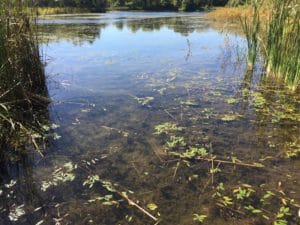
Excessive Submerged Weed Growth
If you have a pond or small lake, chances are that you will have to deal with undesirable aquatic growth at some point. The amount of growth is a function of water depth, water clarity, and nutrient levels. There is no sure-fire method to prevent weeds and algae from taking hold in your pond. Fortunately, there are many integrated management techniques to control the growth once it is present. The question is, at what point does the growth become detrimental to the pond?
It Depends on How Your Pond is Used
The answer to this question is often determined by the use of the resource. If a pond is solely used for aesthetic purposes, the perception may be that any amount of aquatic weeds is detrimental. An example would be a very well-manicured golf hazard. In urban storm water retention ponds, aquatic weeds and algae can cause many problems. These include promoting stagnant water that is suitable for mosquito breeding, clogging of drain overflows, interfering with normal operation of fountains and aerators, and collecting trash and debris. Therefore, the case may be that all submersed weeds and algae should be eliminated. However, this is not always true, since some plants actually improve water quality and help minimize noxious algae growth.
Submersed Weeds Can Help Fish, or Hurt Them
The question of “how much is too much?” gets a little trickier when it comes to ponds and lakes that are primarily used for fishing. The benefits of submersed weed growth include safe haven for baitfish and young gamefish. In low-to-moderate amounts, submersed weeds also help maintain healthy levels of dissolved oxygen, the key word being moderate. In cases of excessive weed growth, the oxygen demand during nighttime hours may exceed the threshold for fish survival. Likewise, floating plants such as duckweed and watermeal can completely restrict sunlight penetration and prevent oxygen production below the surface. So at what point should measures be taken to control the growth?
A general rule of thumb in fisheries science is that any more than 20% coverage of submersed aquatic vegetation can be detrimental to quality fish production. This is because too much cover for baitfish disrupts the normal feeding behavior of sight feeding gamefish such as largemouth bass. The smaller fish hide in the weeds allowing them to escape predation. As a result, the baitfish will overpopulate and stunt at a size too small to provide adequate forage for encouraging bass growth. The end result is a pond full of 1-3 inch bluegill and skinny bass. On the other hand, some weed coverage provides good habitat for young gamefish to flourish until they reach adulthood. Therefore, the trigger to control the weeds is primarily based on the amount of coverage.
The Kind of Vegetation Makes a Difference
Another determining factor is the kind of vegetation present. Floating leaf vegetation such as American pondweed and some water lily species have minimal biomass under the water surface. These types of plants have single stems that rise to the surface and produce floating leaves. These particular plants provide shade for fish and are thus considered desirable species. They typically do not spread far beyond the shallow areas around the shoreline. On the other hand, submersed plants such as bushy pondweed and coontail tend to grow to deeper depths and have very dense underwater biomass. In severe cases, they can completely choke out the water column from the pond bottom to the surface. And finally, fast spreading, exotic species such as salvinia, hydrilla, and water hyacinth should always be controlled regardless of their coverage.
Desirable aquatic plants in moderation can help reduce algae growth. Plants like American Pondweed occupy very shallow areas that would otherwise be covered in unsightly, filamentous algae. Since algaecide treatments are short lived in these areas, it may be a better solution to preserve desirable plants in very shallow portions of the pond. Desirable plants also aid in nutrient reduction. Shoreline, emergent plants are beneficial in preventing erosion and filtering excess nutrients from landscape runoff. Examples of desirable emergents include water willow, iris, arrowhead, and some rush species.
Our biologists at Magnolia Fisheries will consult with you on when and how to take action against nuisance aquatic growth. We will identify the species present, measure the total coverage, and provide you with multiple options for control.
